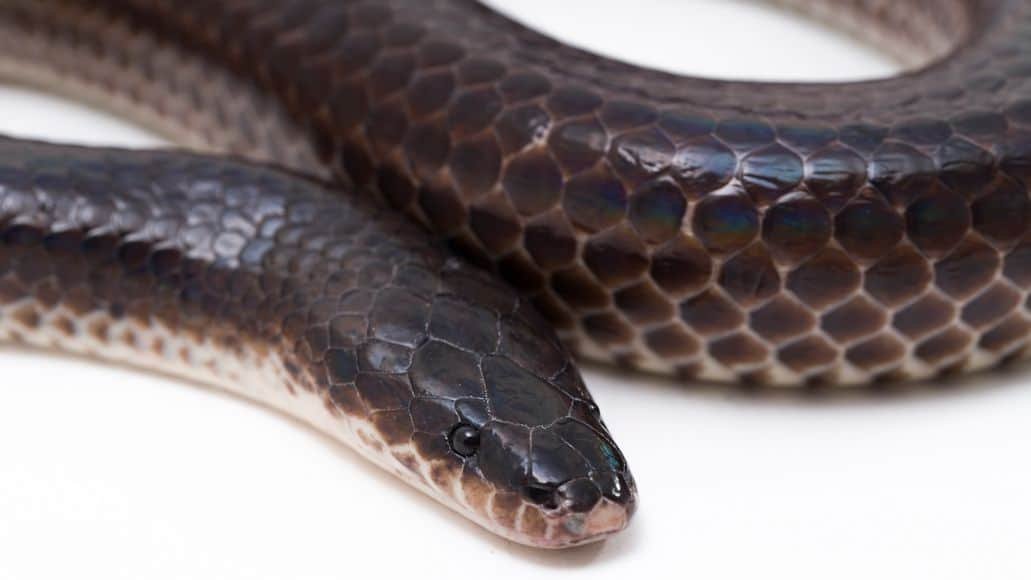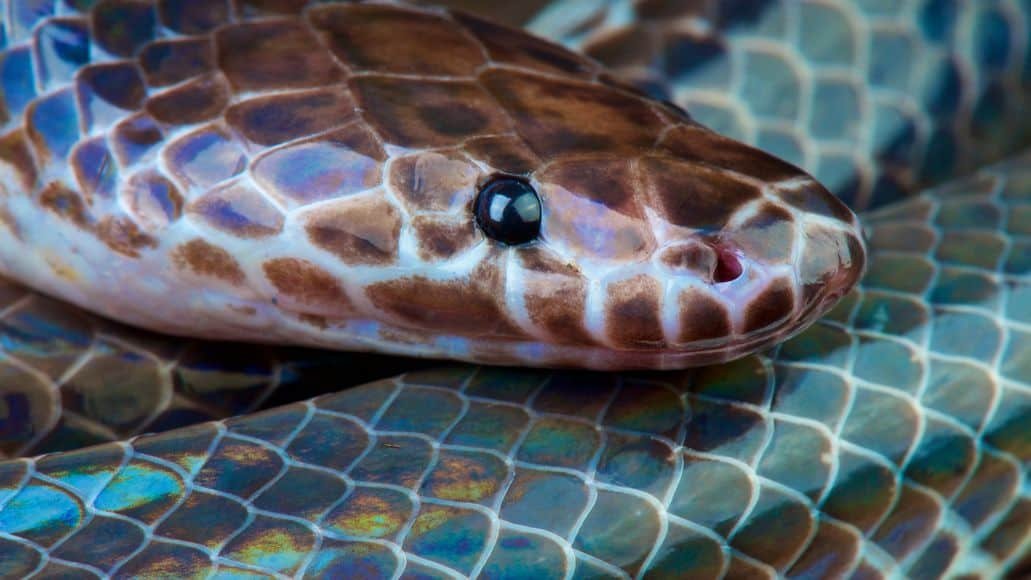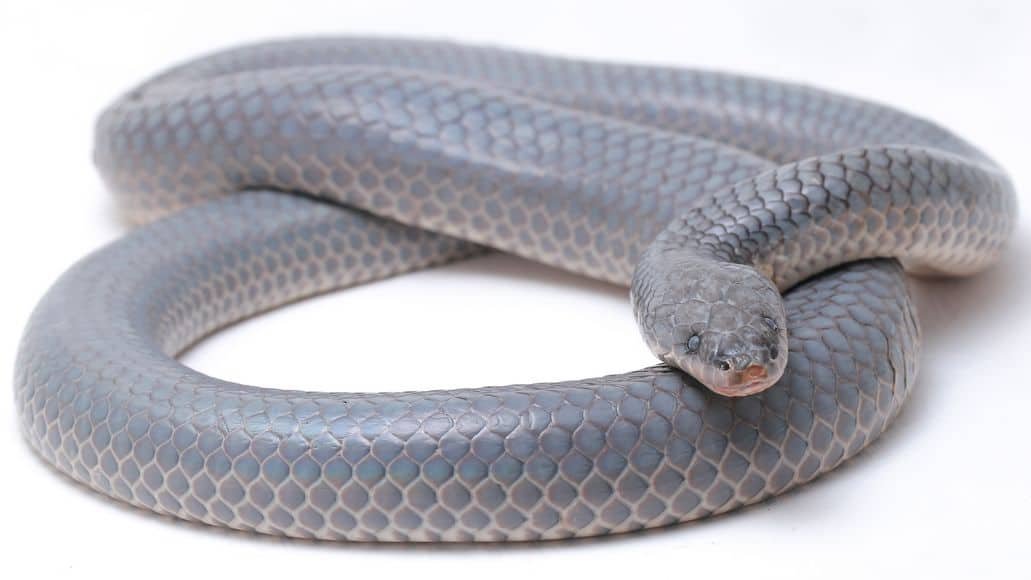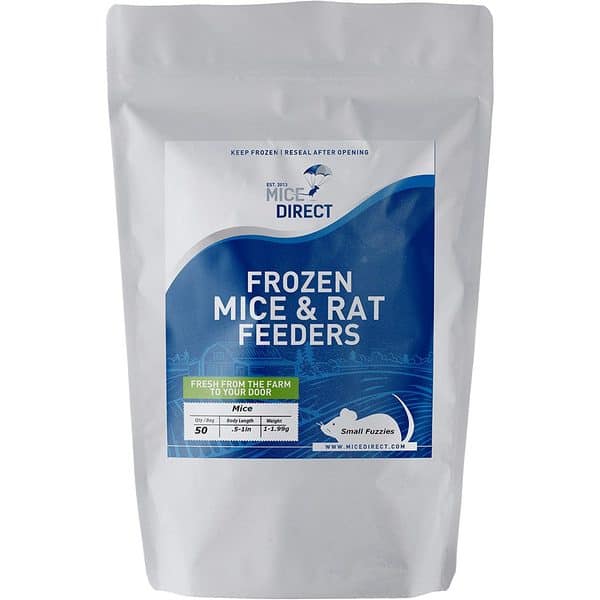
They only shimmer their rainbow colors in direct sunlight or under the right artificial lighting.
But because they like to spend much of their time underground, they rarely show off their natural beauty.
They also like to be left alone and they need very specific environmental conditions.
All of this makes them less suitable as pets than many other easy-to-care-for snake species.
If you can accept your snake for the withdrawn loner that it is, then you may be the right candidate to own a sunbeam snake. If not, you’ll be better off with a different species.
This article on sunbeam snake care will help you figure out if you are the right kind of person to own one of these gorgeous creatures.
Table of Contents
Sunbeam Snake Info
The first time you see a sunbeam snake (Xenopeltis unicolor) in the sun, you will immediately understand how it got its name.
When the sun’s rays hit the snake’s skin, the scales radiate a shimmering iridescence. It is not the only iridescent snake, but it is easily the most brilliant.
But without the sun in play, this snake looks completely plain. It is rare to see its beauty, which is why it did not make our list of the most beautiful snakes.
The belly is cream-colored or white, while the rest of the snake is usually a deep brown or black, but can also look gray. They have a pointy head that is only slightly wider than the rest of their body, and small eyes.

Sunbeam snakes belong to the more primitive group of snakes that include boas and pythons. As such, they have two lungs, instead of the single lung we see in more advanced species. It does not have the pelvic girdle.
The scales overlap, which means less friction and less possibility for dirt or parasites to find a foothold. This is very useful for a burrowing snake like this one.
The scales have minuscule ridges the run in the direction of the animal’s length. These help it in burrowing, and also cause the rainbow colors. When sunlight hits these ridges, it is refracted into all the colors of the rainbow. This is similar to the more well-known rainbow boa snake.
Sunbeam Snake Care Guide
Despite its scales acting like a prism in sunlight to give the snake an iridescent appearance, the sunbeam snake is not overly popular as a pet.
The primary reason they are not more commonly kept as pets is that they have pretty specific care requirements and there is not much information available online to help. You’ll find tons of detailed guides for popular snakes, but very few guides at all for the sunbeam snake, and virtually no good ones.
Until now. We decided to write this guide for anyone considering one of these snakes as a pet, but who was having trouble finding a good source of information.
The good news is that sunbeam snakes are hardy and actually fairly easy to care for. You just have to make sure you provide the proper habitat and environment.
Sunbeam Snake Habitat
The sunbeam snake lives in rice paddies in Asia, which means any southeast Asian country like Thailand, Laos, Cambodia, the Philippines, and more. This means a humid environment with a lot of moisture in the soil and many places to hide. This snake loves to burrow and spends much of its time underground.
In order to mimic this natural environment, you will need to provide a hot and humid habitat, with plenty of substrate for burrowing. The substrate should not only be good for digging, but also hold moisture well, since the dirt in rice paddies is always wet.

Keep humidity levels in the enclosure between 80% and 100%. You will almost certainly have to use a mister or fogger to keep humidity levels high. Read Reptile Fogger Vs. Mister to find out which is better for your needs.
The ambient temperature in the enclosure should be around 80° F. You also need a hot spot that is at least 85° F, but can be as warm as 90°.
A heating mat is best to create this hot spot, but a heating bulb can work, too. You just need to make sure it does not dry out the snake too much. You also want to use a heat bulb that does not give off any light.
Enclosure
It is important to have an enclosure you can seal off. It needs to shut tightly to avoid escapes and also to hold in heat and humidity. You can use a terrarium with a screen top, but you’ll want to cover it with plastic or foil.
If you plan on having many snakes, a rack system with a minimum size of 32 quarts is best. For one snake, get a terrarium of 20 gallons or more (it can be 10 gallons for a younger snake, but why not just get a larger size from the start).
You want a long enclosure, instead of a tall one, since these snakes like having space to burrow and they do not climb. Our article on the best terrariums for snakes will help you find the right one.
Make sure you get one where the mesh top locks shut (these snakes are very skilled at escaping). As mentioned, you also want to cover the mesh screen to keep in heat and humidity.
You can use a thermostat like these to control the temperature. Remember, it should be around 80° F, with a hot spot at 85° to 90° F.

Substrate
The most important factors when choosing your substrate is that is hold moisture well and that it is good for burrowing. We have an entire article on choosing the best snake substrate that can help.
If you just want a quick recommendation, a coconut-bases bedding is idea, because it retains moisture and is great for burrowing. Zoo Med’s Eco Earth is our top choice.
You will want to fill the tank with about 6 to 8 inches of substrate to allow your snake plenty of space for burrowing around. Make sure the substrate is always damp, but don’t let it get soaking wet, because this could lead to the formation of blisters on the snake’s skin.
Diet
In the wild, sunbeam snakes eat animals that are commonly found in rice paddies. This means these snakes eat frogs, lizards, rodents, or other snakes. But you can easily feed them thawed frozen mice like these:
If your snake is small, i.e. under 2 feet long, feet it fuzzy mice. If it is larger, you can feed it small adult mice.
You usually want to feed it 2 to 3 mice at a time. They can’t open their mouths as wide as other snakes, so instead of eating one larger meal, they are better off eating a few smaller animals at the same time.
Since most sunbeam snake pets are wild caught, they may not want to eat thawed mice. If that is the case, you’ll have to start them on live mice. We have an article covering where you can buy live mice to feed your snake.
Establish a feeding schedule, then after a while, you can simply present them thawed mice at the same time you would usually give them live ones. They will eat them.
Younger snakes should eat once a week, but fully grown adults only need to be fed once every two weeks. How long can a snake go without eating? A very long time, but that doesn’t mean they should. Make sure to feed your pet regularly.
Water
Sunbeam snakes like to have the occasional soak, so you want to provide them with a shallow water dish that has enough space for them to get inside. Make sure it is always filled with fresh water. These snakes tend to get substrate in their water dish.
Handling

Sunbeam snakes are docile animals, but they do prefer to be left alone. They do not like being handled very often and it stresses them out. We recommend handling them as little as possible. If you want a snake you can hold a lot, get a different breed.
You should also avoid stressing them in other ways, like poking them, etc. Not only are high stress levels bad for them, but it can also be bad for you, or specifically, for your nose. You see, when they get stressed, they can excrete a musk with a very unpleasant odor.
Choosing A Sunbeam Snake
When picking out a sunbeam snake, you want to make sure you get a healthy and strong animal. It should feel strong and not be limp or weak. Shyness is not an indication of weakness, so don’t be put off by a shy snake.
Most sunbeam, snakes that are available are wild caught. This means they may have some health issues. Blisters are a common problem, due to the wet environment they come from.
If a snake has been recently caught, a few blisters are not unusual or anything to worry about. But if it has a ton of blisters, or even larger problems like snake scale rot, you’ll want to pass.
This is even more true if the animal has not been recently caught and has already been with the seller for quite some time, because in this case, these issues indicate that the snake has been kept in unsanitary conditions and it will likely have numerous other issues.
You should also look at the body size. You want a snake that is a bit wider than it is tall. It should be plump and round. You do not want to see any folds in the skin, since these could indicate inadequate nutrition or hydration.

Captive-Born Vs. Wild-Caught
Usually we recommend captive-born snakes over wild-caught, but that is not really an option when it comes to sunbeam snakes. For now, more than 99% of the snakes for sale on the pet market are caught in the wild.
The reason for this is that no one has yet been able to successfully breed them in captivity. Sure, some keepers have managed to get their females to lay some eggs, but they have not been able to do so consistently.
Part of the problem is likely that not many people are trying. since this snake is not that popular as a pet and it is easily found and caught in the wild, there is not much incentive to breed them.
And the good thing is that the wild-caught sunbeam snakes are generally pretty healthy and do not suffer from many of the issue other wild-caught species do.
Sunbeam Snakes: Final Thoughts
Sunbeam snakes can be incredibly beautiful when they are in direct sunlight or beneath the right artificial light. They are also quite easy to take care of. Nevertheless, we do not recommend them for most people.
These snakes like to be left alone and they like to spend much of their time underground. You will rarely see their shimmering scales and you will not get to spend much one on one time with them. If you are fine with this, then a sunbeam snake might be for you.
As long as you provide it the right environment, meaning a hot ans humid enclosure with plenty of moist substrate to burrow around in, your new pet will be very happy. Assuming you leave it alone and don’t bug it too much, of course!


Leave a Reply